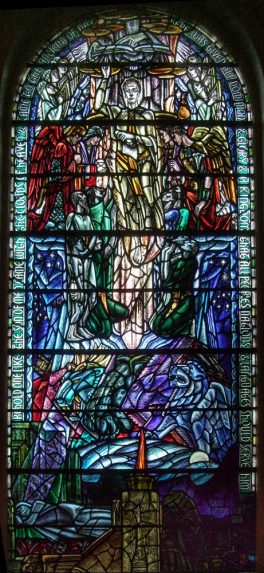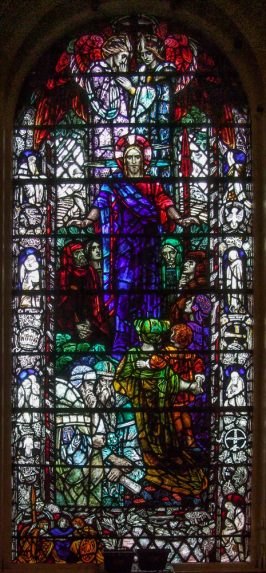1- St Andrew's and St George’s West Church, Edinburgh
Address
St Andrew's and St George’s West Church, 13 George Street, Edinburgh EH2 2PATheme
Overview
This entry is part 1 of a 10 part essay by Douglas Hogg with the title “The Lion in the North – a 20th century lineage – A personally immersive account of the development and influence of a progression in the use of glass painting in Scotland as an expressive form, with particular reference to this as a unique and identifiable east coast phenomenon.” The full essay can be read in the themes section, where there are also links to each of the locations that are discussed.
Highlight
Two Gallery windows. North – The Beatitudes (Webster) , South - The Son of Man (Strachan)Artist, maker and date
Alfred Webster, 1913 & Douglas Strachan, 1934Reason for highlighting
Standing in the circular well of St Andrew’s and St George’s West Church Edinburgh, looking back and up to the gallery, two fulsomely large circle-top windows bear down on us. Looking relatively similar in terms of their compositional presence and scaling they may at first sight seem to share much in common with each other. In fact they perfectly reflect the quite different cultures which, by way of their histories, exist at either end of the central belt, a mere 39 miles. The windows carry within them the essential characteristics of being at either side of a cultural divide : of an east coast / west coast differential. Perhaps these differences may start early with contrasting geographies. Up and down the entire east coast the North Sea plunges bursts and tugs persistently at the coastline resulting in tall cliffs and stony beaches. On the west coast it seems as if the ocean is invited far in to the land, each gentle tide creeping across low shorelines and moving up long sea-lochs. The best hills are arguably in the west. In socio-historical terms the 5th and 7th centuries AD saw Christianity first come to western shores. They named this Dalriada, a Gaelic kingdom encompassing both the eastern seaboard of Northern Ireland and the western seaboard of Scotland. The river Clyde eventually became a centre of heavy industry and ship-building while Edinburgh and the east coast with long established trading links with Europe became associated more with culture and learning. The two Scottish colleges involved in training for the ministry, Trinity College in Glasgow and New College in Edinburgh, even now strike deeply varying emphases in the structure and focus of their work. While in a recent tribute to Rolling Stones’ pianist Ian Stewart, Mick Jagger recounted that he had always laid great emphasis on the fact that he was from the east coast of Scotland. So what’s going on?
Up in the gallery, standing directly in front of each window, the left-hand is by Alfred (Alf) Webster of Glasgow, the right by Douglas Strachan of Edinburgh. Both artists are obviously consummate masters of their art, each capture the aesthetic influences of their time and reflect perfectly the nature of each of the two great cities. Webster’s work reflects the strong Scotia / Hibernian roots of the largely catholic industrial west while Strachan takes on board the mobile influences of a contemporary European art. His mannered, toughly wrought graphic style reflects an acquaintance with the vorticist movement current in Europe at that time. Strachan’s choice of colour range (narrower than Webster’s) in combination with a “clean” technique balances the considerations of a strong southern light beautifully. In this work we can detect the almost psychological pulse which permeates his larger compositions. With Webster, a broader palette of colour and a brooding sense of an emanating glow is accompanied by a fine, if rather dusty, on-glass stipple modelling that I associate with the nature of west coast glass painting. Sadly, Alf Webster died in the Great War just a year or two after this window was installed in 1914 and it is at this point that I believe Scotland lost one of its limbs in the flourishing of Scottish stained glass and its subsequent development.
Strachan’s much utilised technique of “plating” glass on glass in order to achieve the correct hue of colour and tone can be seen on his window when viewed externally.
This is the first part of a 10 part essay, to continue reading please follow the link below
Part 2 – Westruther Parish Church
Alternatively the whole essay, without pictures, can be read as a PDF here
Other comments
Note: On 1 February 2024, the Church of St Andrew’s and St George’s West was joined, at its George Street address, by the congregation of Greenside Parish Church, to become Edinburgh: The New Town Church of Scotland.
Artist/maker notes
Alfred Alexander (Alf) Webster (1883-1915) enrolled at the Glasgow School of Art in 1903 and the following year joined the studio of Stephen Adam, becoming a partner in 1909 and taking over the studio the following year after Adam’s death. After joining Adam he rapidly proved himself to be an artist of extraordinary talent capable, who, as Donnelly notes, “was producing glass which, for technical control of colour, texture and transparency, alone among his contemporaries, can bear comparison with that other genius of stained glass, the Irish artist Harry Clarke”.
Tragically he was killed in Flanders in August 1915, aged just 31, having taken a commission as a 2nd Lieutenant in the Gordon Highlanders.
Source: Scotland’s Stained Glass Making the colours sing by Michael Donnelly (Historic Scotland, 1977)
Robert Douglas Strachan (1875-1950) was born in Aberdeen and initially trained as an artist. Indeed Strachan admitted later in life that he had been slow to realise that stained glass would be the best outlet for his artistic vision. It was a vision that enable him to become the foremost British stained glass artists of the generation after Christopher Whall. From 1909 to 1911 he was head of the School of Design and Crafts at the Edinburgh College of Art, before handing over to his brother, Alexander, due to pressure of work. His windows are found throughout Scotland and England, and are recognisable for their bold use of colour, and strong sculptural design and use of lead. Overseas he is renowned for his windows at the Peace Palace in The Hague, The Netherlands.
Sources:
In Praise of Douglas Strachan by Peter Cormack, Journal of Stained Glass, Vol. XXX, 2006
Arts & Crafts Stained Glass by Peter Cormack (Yale University Press for The Paul Mellon Centre for Studies in British Art, 2015)
ECA Glass Alumni Exhibition Catalogue, pages 11-12
An immersive and reflective account of the life and work of Douglas Strachan can be found online in a PhD thesis by Professor Juliette Macdonald for St Andrew’s University. Professor Macdonald is currently Head of the School of Design / Personal Chair of Craft History and Theory at ECA. Aspect of identity in the work of Douglas Strachan (185-1950) – St Andrews Research Repository



Comments by
Douglas Hogg